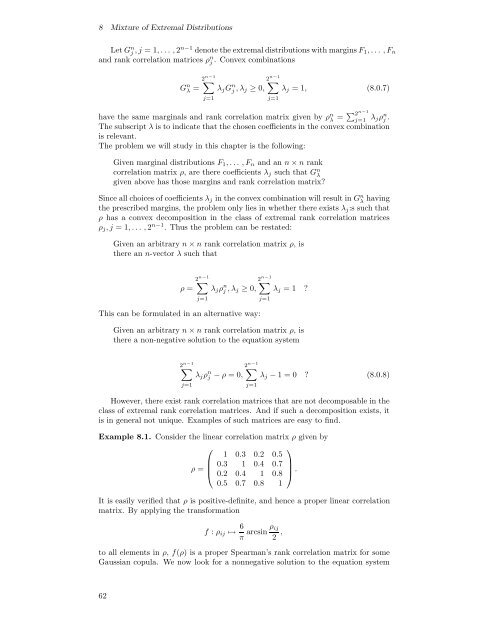Modelling Dependence with Copulas - IFOR
Modelling Dependence with Copulas - IFOR
Modelling Dependence with Copulas - IFOR
Create successful ePaper yourself
Turn your PDF publications into a flip-book with our unique Google optimized e-Paper software.
8 Mixture of Extremal Distributions<br />
Let G n j ,j =1,... ,2n−1 denote the extremal distributions <strong>with</strong> margins F 1 ,... ,F n<br />
and rank correlation matrices ρ n j . Convex combinations<br />
2 n−1<br />
G n λ = ∑<br />
j=1<br />
2<br />
λ j G n j ,λ ∑<br />
n−1<br />
j ≥ 0,<br />
j=1<br />
λ j =1, (8.0.7)<br />
have the same marginals and rank correlation matrix given by ρ n λ = ∑ 2 n−1<br />
j=1 λ jρ n j .<br />
The subscript λ is to indicate that the chosen coefficients in the convex combination<br />
is relevant.<br />
The problem we will study in this chapter is the following:<br />
Given marginal distributions F 1 ,... ,F n and an n × n rank<br />
correlation matrix ρ, are there coefficients λ j such that G n λ<br />
given above has those margins and rank correlation matrix?<br />
Since all choices of coefficients λ j in the convex combination will result in G n λ having<br />
the prescribed margins, the problem only lies in whether there exists λ j :s such that<br />
ρ has a convex decomposition in the class of extremal rank correlation matrices<br />
ρ j ,j =1,... ,2 n−1 . Thus the problem can be restated:<br />
Given an arbitrary n × n rank correlation matrix ρ, is<br />
there an n-vector λ such that<br />
ρ =<br />
2∑<br />
n−1<br />
j=1<br />
2<br />
λ j ρ n j ,λ ∑<br />
n−1<br />
j ≥ 0,<br />
This can be formulated in an alternative way:<br />
j=1<br />
λ j =1 ?<br />
Given an arbitrary n × n rank correlation matrix ρ, is<br />
there a non-negative solution to the equation system<br />
2∑<br />
n−1<br />
j=1<br />
2 n−1<br />
λ j ρ n j − ρ =0, ∑<br />
j=1<br />
λ j − 1 = 0 ? (8.0.8)<br />
However, there exist rank correlation matrices that are not decomposable in the<br />
class of extremal rank correlation matrices. And if such a decomposition exists, it<br />
is in general not unique. Examples of such matrices are easy to find.<br />
Example 8.1. Consider the linear correlation matrix ρ given by<br />
⎛<br />
⎞<br />
1 0.3 0.2 0.5<br />
ρ = ⎜ 0.3 1 0.4 0.7<br />
⎟<br />
⎝ 0.2 0.4 1 0.8 ⎠ .<br />
0.5 0.7 0.8 1<br />
It is easily verified that ρ is positive-definite, and hence a proper linear correlation<br />
matrix. By applying the transformation<br />
f : ρ ij ↦→ 6 π arcsin ρ ij<br />
2 ,<br />
to all elements in ρ, f(ρ) is a proper Spearman’s rank correlation matrix for some<br />
Gaussian copula. We now look for a nonnegative solution to the equation system<br />
62
















